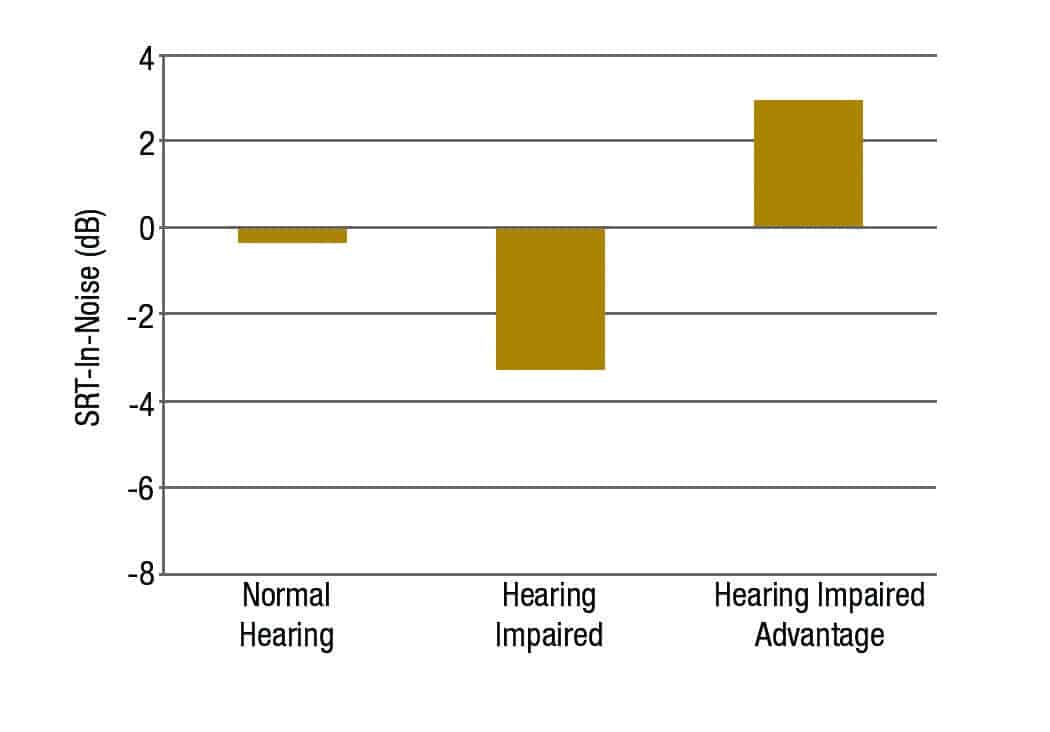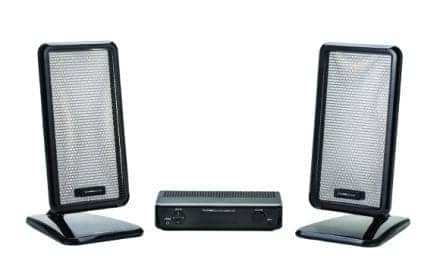Tech Topic | November 2014 Hearing Review
By Thomas A. Powers, PhD, and Matthias Froehlich, PhD
Results are summarized here for the clinical trials of a new hearing aid directional technology that employs binaural beamforming through the use of wireless audio data streaming. At two independent research sites, sentence recognition in surrounding background noise was significantly superior for individuals with mild-to-moderate hearing loss, when aided with this technology, compared to individuals with normal hearing. The performance advantage for the hearing-impaired groups was 2-3 dB SNR.
While many advances have been made in hearing aid technology over the past few decades, better understanding of speech in background noise continues to be a common request from hearing aid users, and as a result, a priority design criterion for manufacturers. Data from MarkeTrak VIII reveals that only 37% of hearing aid users are either “very satisfied” or “satisfied” with the performance of their hearing aids in background noise.1 Moreover, poor benefit in background noise is the leading reason why individuals who already own hearing aids say they never use them.
Historically, directional technology has been the most successful wearable solution for the speech-in-noise problem. Since the inception of the directional microphone hearing aid (introduced in Germany in the late 1960s), Siemens has been at the forefront of development and research. Over the past 15 years, clinical studies have supported the patient benefit that can be obtained from dual-microphone directional instruments,2 the three-microphone directional system,3 adaptive directional microphones,4 an anti-cardioid directional algorithm,5 and a unique integration of noise reduction and directional processing.6
The most recent development with directional hearing aids involves wireless communication, which allows for the exchange of audio data received by the microphones of both the right and left hearing aids, which then can be used to achieve narrow beamforming. This new technology was described by Kamkar-Parsi et al in last month’s Hearing Review.7
To review briefly, the beamforming algorithm takes as inputs the local signal and the contralateral signal, which is the signal transmitted from the hearing aid located on the other side of the head, via the binaural wireless link. The output of the beamformer is generated by linearly adding the weighted local signals and the weighted contralateral signals. Kamkar-Parsi et al7 report that this binaural processing differs from other schemes of this type in that the beamforming is fully adaptive, has dedicated integration of binaural noise reduction, and operates with minimal additional battery drain.
Research with new directional products typically compares performance with the new instruments to omnidirectional processing, a previous generation of directional technology, or in some cases the leading competitor’s products. While this type of evaluation can provide an indication of relative benefit, it does not relate directly to the absolute benefit that can be obtained from the instruments for the average patient.
We believe that a more appropriate assessment of the true patient benefit is to compare the performance for individuals using the hearing aids to people with normal hearing. This approach is not new; it is what we used 10 years ago when the three-microphone directional product was introduced (see Bentler et al3 for review). Therefore, to evaluate the new Siemens binax binaural beamformer, we designed a clinical protocol that would assess speech recognition in background noise, with participants consisting of normal-hearing individuals and hearing-impaired listeners fit with this new beamforming technology.
Clinical Protocol
The clinical studies were conducted at two independent research sites: Hörzentrum Oldenburg (Site 1) in Germany, and the University of Northern Colorado (UNCO) in Greeley, Colo (Site 2). At both sites, two groups of participants were tested: normal-hearing (audiometric threshold of 25 dB or better) and hearing-impaired individuals were fitted with the beamforming technology. All the hearing-impaired participants had symmetrical downward sloping sensorineural hearing losses, with mean audiograms ranging from 25-30 dB in the low frequencies, to 55-60 dB for the 3000-4000 Hz region. At Site 1, the mean age of the normal-hearing group (n=15) was 64.5; the mean age of the hearing-impaired group (n=29) was 68.8. At Site 2, the normal-hearing group (n=14) had a mean age of 58.1 compared to a mean age of 65.8 for the hearing-impaired group (n=14).

[Click on image to enlarge.] Figure 1. Illustration of the test setup. The participant (yellow head) sat in the middle, with target speech presented from 0°, and competing speech from the other seven loudspeakers.
The target speech material used at Site 1 was the sentences of the Oldenburg Satztest,8 commonly referred to as the OLSA. The background competing signal was also the OLSA sentences, presented uncorrelated from the seven different loudspeakers surrounding the listener, with the gaps between sentences removed. Additionally, speech babble was added to the competing material, presented at a level 15 dB below the sentences.
At UNCO (Site 2), the target speech material was the sentences of the Hearing In Noise Test (HINT).9 Consistent with the test conditions of Site 1, the competing signal was the HINT sentences, with the gaps between sentences removed, presented uncorrelated from the seven loudspeakers surrounding the listener. The same speech babble used at Site 1 was also added to the competing sentences, presented 15 dB below the sentence material. Standard presentation and scoring methods for both the OLSA and the HINT were used. The background noise was constant (72 dB SPL) and the sentences were presented in an adaptive manner.
Prior to experimental testing, all hearing-impaired participants were fit with the Siemens binax™ Pure 7bx receiver-in-the-canal (RIC) instruments. The hearing aids were programmed according to the Siemens proprietary fitting algorithm (referred to as “binax fit” in the Connexx® fitting software). The beamforming algorithm, called Narrow Directionality, was selected. All other special features were also activated, and set to default settings. The hearing aids were coupled to the ear using standard Siemens double-dome RIC fitting tips.
Clinical Test Results
Independent clinical testing was conducted at both sites to compare the speech recognition of normal-hearing individuals to hearing-impaired listeners fit with Siemens binax hearing aids using the binaural beamforming algorithm. At both sites, a speech-in-noise test was administered to allow for calculation of the 50% correct point for speech recognition.

Figure 2. Mean speech recognition threshold in noise (dB) at Site 1 for listeners with normal hearing, and the impaired hearing groups fit bilaterally with binaural beamforming hearing aids.
The mean findings for Site 1 are shown in Figure 2, and the mean results for Site 2 are in Figure 3. For both sites, there was a substantial difference between groups, with the hearing-impaired group performing better than the individuals with normal hearing.

Figure 3. Mean speech recognition threshold in noise (dB) at Site 2 for listeners with normal hearing, and the impaired hearing groups fitted bilaterally with binaural beamforming hearing aids.
The SNR advantage was 2.1 dB for Site 1 and 2.9 dB for Site 2. This difference was statistically significant for both sites (Site 1: F1,44 = 17.23, p < 0.001; Site 2: (F1,28 = 8.35, p < 0.01). Further analyses revealed no significant interaction for age or degree of hearing loss for the hearing-impaired group for either site (p >.05).
To facilitate the interpretation of the substantive effects of the significant differences between groups, the Cohen’s d statistic was applied. The results revealed a Cohen’s d=1.09 for Site 1, and Cohen’s d=1.02 for Site 2. This is considered a “large” effect.
The fact that the absolute values of the test scores are about 3 dB better for Site 1 compared to Site 2 is not significant or surprising. First, recall that these are two different tests, in different languages, that may not be equivalent in difficulty. The sentences of the OLSA have a predictable structure, and it is probably easier to correctly repeat a word by guessing than for the HINT. The two tests are also scored differently—the OLSA scores each word of a sentence, whereas for the HINT all key words must be repeated correctly before the sentence is scored correct.
Conclusion
These clinical studies were designed to compare the new Siemens binaural beamformer to a high standard: the performance of normal-hearing individuals for the same listening task. The results are clear: when aided with this technology, sentence recognition in surrounding background noise for individuals with mild-to-moderate hearing loss was significantly superior compared to individuals with normal hearing. As shown in Figures 2 and 3, the hearing-impaired individuals using the binaural beamformer not only performed equal to normal-hearing individuals, but significantly better. The advantage was a minimum of 2 dB for both sites, and nearly 3 dB for Site 2—enough to be noticeable in many real-world situations.
It is important to note that Narrow Directionality is fully integrated into the automatic program and shifts seamlessly from the standard directional microphone mode to provide the appropriate directional setting for various listening situations. It activates and deactivates automatically when necessary, and provides a smooth transition between these two states to maintain optimal sound quality—even in the transition phase. Benefits to the user include no need for manual adjustments with minimal battery consumption.
References
1. Kochkin S. MarkeTrak VIII: Customer satisfaction with hearing aids is slowly increasing. The Hearing Journal. 2010;63(1):11-19.
2. Ricketts T, Dhar S. Comparison of performance across three directional hearing aids. J Am Acad Audiol. 1999;10(4):180-189.
3. Bentler RA, Palmer C, Dittberner AB. Hearing-in-noise: comparison of listeners with normal and (aided) impaired hearing. J Am Acad Audiol. 2004;15(3):216-25.
4. Ricketts TA, Hornsby BW, Johnson EE. Adaptive directional benefit in the near field: competing sound angle and level effects. Seminars in Hearing. 2005;26(2):56-69.
5. Mueller HG, Weber J, Bellanova M. Clinical evaluation of a new hearing aid anti-cardioid directivity pattern. Int J Audiol. 2011;50(4):249-54.
6. Powers T, Beilin J. True advances in hearing aid technology: what are they and where’s the proof? Hearing Review. 2013;20(1).
7. Kamkar-Parsi H, Fischer E, Aubreville M. New binaural strategies for enhanced hearing. Hearing Review. 2014;21(10):42-45.
8. Kollmeier B, Wesselkamp M. Development and evaluation of a German sentence test for objective and subjective speech intelligibility assessment. J Acoust Soc Am. 1997 Oct;102(4):2412-21.
9. Nilsson M, Soli SD, Sullivan JA. Development of the Hearing in Noise Test for the measurement of speech reception thresholds in quiet and noise. J Acoust Soc Am. 1994;95(2):1085-1099.
REFERENCES can also be found by clicking in the digital edition of this article at: http://hr.alliedmedia360.com
CORRESPONDENCE to Dr Powers at: [email protected]





